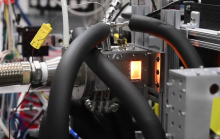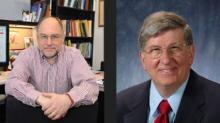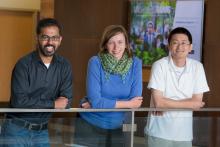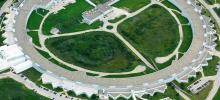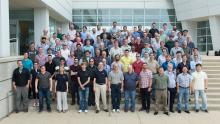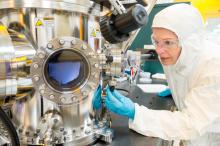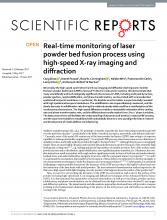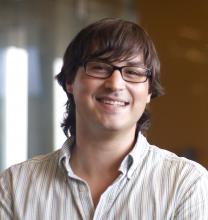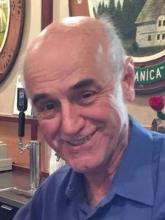2018
Physicists working at the U.S. Department of Energy's Advanced Photon Source think they have achieved one of the most coveted goals of their discipline: creating a superconducting material that works at near-room temperature.
Imaging and measuring the atomization process in a gas turbine combustor using the bright x-rays from the U.S. Department of Energy’s Advanced Photon Source has been chosen by RDECOM Research Laboratory, the Army's corporate research laboratory under the Army Research Laboratory (ARL), as one of the 2018 top 10 “coolest” advances.
The Advanced Photon Source has developed the innovative horizontal gap vertical polarization undulator (HGVPU) for the Linac Coherent Light Source-II (LCLS-II) x-ray free-electron laser project at the SLAC National Accelerator Laboratory. The APS transferred the complete documentation on the HGVPU to Lawrence Berkeley National Laboratory, where 34 of the devices will be fabricated for the LCLS-II.
Brian H. Toby and Robert Von Dreele of the U.S. Department of Energy’s Advanced Photon Source at Argonne National Laboratory have been selected as the recipients of the American Crystallographic Association 2019 Trueblood Award.

Deadline for submission: Friday, Oct. 26, 2018
The Advanced Photon Source (APS) is seeking user science proposals and requests for beam time on existing proposals.
David Keavney of the Argonne National Laboratory X-ray Science Division at the U.S. Department of Energy’s Advanced Photon Source has been awarded an American Association for the Advancement of Science Science & Technology Policy Fellowship (STPF) with a placement at the U.S. Department of State, Bureau of Energy Resources.
Argonne National Laboratory will be taking over the operations management role for the High-Pressure Collaborative Access Team (HP-CAT), at Sector 16 of the APS currently filled by the Carnegie Institution for Science, effective later this month. The sponsor will continue to be the U.S. Department of Energy National Nuclear Security Administration.
Three Argonne National Laboratory researchers, including one from the X-ray Science Division (XSD) at the U.S. Department of Energy’s (DOE’s) Advanced Photon Source, have earned the DOE’s 2018 Early Career Research Program awards.
The deadline for APS proposals and beam-time requests for cycle 2018-3 is Friday, July 6, 2018, 11:59 PM Chicago time.
The APS hosted the June 2018 EPICS Collaboration Meeting, an international conference of users and developers of the EPICS Control System software tool-kit.
As the APS Upgrade Project (APS-U) moves forward, we want to reach out even further to scientific communities and leaders in order to involve them with beamline upgrade projects, and motivate them to prepare for more challenging experiments. Hence, the APS-U will organize a series of scientific workshops in 2018-2020.
The Center for Nanoscale Materials (CNM) is soliciting proposals for user-initiated nanoscience and nanotechnology research. The CNM provides users with access to a broad range of capabilities for design, synthesis, characterization, and theory and modeling in order to significantly advance the understanding of nanoscale phenomena and develop functional nanoscale systems. Access is provided at no cost to users for research that is in the public domain.
Yang Ren, a physicist with the X-ray Science Divisio at the U.S. Department of Energy’s Argonne National Laboratory, joins eight colleagues and co-authors as winners of the American Iron and Steel Institute “2018 Institute Medal” for their paper “Deformation Mode and Strain Path Dependence of Martensite Phase Transformation in a Medium Manganese TRIP Steel.”
The 2018 Gopal K. Shenoy Excellence in Beamline Science Award was awarded on May 7th, 2018, to Hua Zhou, a physicist in the Surface Scattering and Microdiffraction Group of X-Ray Sciences Division at the Advanced Photon Source.
The U.S. Army Research Laboratory's Center for Unmanned Aircraft Systems Propulsion made an historic first with its experiment in a gas turbine combustor using x-rays at the U.S. Department of Energy’s Advanced Photon Source. The data will help advance gas turbine engine designs for higher power density and efficiency, scientists said.
The paper “‘Real-time monitoring of laser powder bed fusion process using high-speed X-ray imaging and diffraction” (Cang Zhao et al., Sci. Rep. 7, 3602-1-3602-11 (2017). DOI: 10.1038/s41598-017-03761-2) received 1079 article views in 2017, placing it as one of the top 25 highly read papers (out of more than 4500 materials science papers) for "Scientific Reports" in 2017.
The APS Users Organization (APSUO) is pleased to announce that the winner of the 2018 APSUO Rosalind Franklin Young Investigator Award is Joshua Riback, a graduate student in the Biophysical Sciences at the University of Chicago. Riback was recognized for his work using small-angle X-ray scattering techniques (SAXS) at the APS to study biophysical interactions.
Center for Nanoscale Materials Director Supratik Guha has been named Senior Science Advisor for the Director of Argonne National Laboratory.
Joe Arko was with the APS from its very first days. He worked in the Experimental Facilities Division and was one of most important contributors to the success of the APS undulator program and the first microfocusing beamline.


